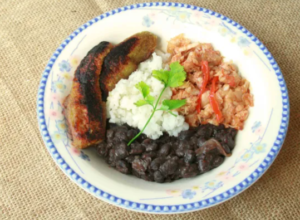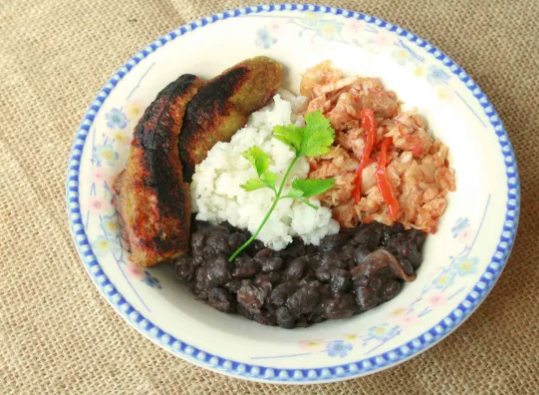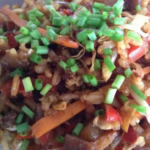The pabellón is the most iconic dish of Venezuelan gastronomy and its cultural miscegenation. Its ingredients are said to be symbolic, since each color is supposed to represent the diversity of cultures that live here in one skin.
The Venezuelan pavilion is endowed with a majestic salty-sweet flavor that is the hallmark of our culinary identity. In addition, this preparation has great nutritional attributes, since it contains all the food groups in its preparation. Generally, this gastronomic creation is made up of shredded meat, white rice, black beans (beans, beans or black beans) and slices (fried ripe plantains) or patacones (fried green plantains). However, as in everything there are variants… and what variants! Can you imagine the pavilion with fish?
Ingredients to make Margariteño Pavilion:
- For the mechada dogfish:
- ½ kilogram of dogfish
- 2 lemons
- 1 cup grated onion
- 3 crushed garlic cloves
- 1½ cups grated tomato
- ½ cup grated red bell pepper
- 1 tablespoon of chopped sweet pepper
- 2 teaspoons of salt
- ½ teaspoon black pepper
- 1 teaspoon Worcestershire willow
- 10 drops of hot sauce
- ½ cup vegetable oil
- 2 teaspoons of annatto or carmencita (grains or powder)
- For the fried beans:
- ½ cup of oil
- ½ cup chopped onion
- 4 cups of cooked beans
- 8 tablespoons of grated paper (brown sugar or white sugar also works)
- Other contours:
- 1 cup white rice
- 2 bananas (green or ripe)
- ½ cup of oil
- 1 pinch of salt
How to make Daisy Pavilion:
- Pour water into a large saucepan and heat until it boils. Then add the dogfish. The cooking times for this fish vary from one recipe to another. In some recipes, the heat is turned off; the dogfish is submerged for a few seconds in the boiling water, removed and reserved. If you do it this way, when it’s time to prepare it in the pan, it will need more cooking time (about 30 minutes). In other recipes, at the beginning when you boil the dogfish, you let it cook for at least 30 minutes. Thus, later when sautéing it in the pan, you will only need approximately 5 minutes of cooking.
- Whether you pass the dogfish in water for a few seconds or let it cook for a long time, then you must let all the water drain and reserve.
- Grate or julienne-style the vegetables, depending on your preference. For the fried beans, you should reserve half a cup of onion, julienne cut. In the case of garlic, crush it. Reserve everything.
- Scrape the skin of the dogfish with a knife until it is removed.
- Tip: If you bought a whole top, first cut and discard both the fins and the center bone, then scrape off the skin.
- Subsequently, rub a lemon over the fish meat to eliminate the smell of ammonia and let it rest for approximately 10 minutes. Then, rinse slightly under the tap.
- Tip: If the smell is very strong, you can wait up to 30 minutes.
- Cut the shark into squares or shred. If you cut it into squares, when you take it to the pan you must stir until it crumbles. On the contrary, if you crumble it, then you must stir it carefully so as not to create a mass.
- Tip: You can cover the shark meat with buttermilk or lemon juice for a few minutes, to eliminate the smell of ammonia.
- Prepare a pan with oil and wait until it is hot. Add the annatto, cook until it boils and remove it immediately from the heat. Strain the oil, discard the seeds and reserve the liquid in a container.
- Heat more oil in the same pan. Next step, add the onion and garlic. Cook until both wilt (soften and brown). Calculate about 4 to 5 minutes approximately.
- Add the tomato, paprika and sweet pepper. Cook for 5 to 7 minutes or until the pabellón margariteño vegetables are tender.
- Later, add the fish along with the salt, pepper, Worcestershire sauce and hot sauce. Apply medium-high heat and wait until it boils. At this point, stir the fish constantly until it is shredded. Remember if you already crumbled it from the beginning, you only need to stir a little so as not to create a mass (mascot). Apply low heat. booking.
- Tip: In total, calculate about 30 minutes of cooking if at first you only cooked a little (you submerged for seconds) or 5 minutes if at the beginning you cooked it for a long time (30 minutes). In either case, wait until you feel the preparation dry.
- Now prepare the fried beans. In another pan, pour a splash of oil and wait until it is hot. Add the onion and fry until golden brown (caramelized onions). Wait around 8 minutes and add the beans. Stir constantly for 2-3 more minutes.
- Tip: Preferably, prepare the beans the day before. If not, leave the beans soaking the night before.
- Meanwhile, on the other burners, prepare the white rice and the fried plantains or, if you prefer, patacones or to stones.
- It’s time for sweetness! Now you will give this dish the typical Venezuelan flavor that is the salty-sweet combination. For this, add the grated piloncillo to the beans (brown sugar or white sugar also works) and incorporate completely. Stir constantly for another 10 to 15 minutes or until the preparation is slightly consumed but without completely losing its juiciness.
- The traditional Creole pavilion is accompanied by white rice, fried ripe plantain slices (pavilion with railing) or green plantain to stones, some even place fried eggs on top (pabellón al caballo). Others prefer to taste the pabellón without meat but with eggplants (vegetarian pavilion), while some accompany this dish with baked or boiled plantains. In the case of the pabellón margariteño , a regional variant of the classic pavilion, the fried meat or shredded meat is replaced by a cazón stew . Pure flavor of eastern Venezuela!




